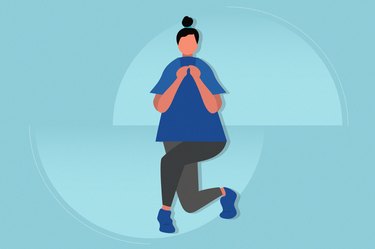

If you want to sculpt your glutes, you've likely tried curtsy lunges before. We're guessing, with mixed results. While some tout it as one of the top lunge variations for your glutes, more and more trainers are saying it's actually a move you should never do.
First, the positives: The exercise — a sort of reverse lunge in which your foot crosses behind your body — not only works your gluteus maximus (the largest muscle in your entire body), but the unique angle of the movement also reaches smaller muscles like your side glutes and inner thighs.
Video of the Day
Video of the Day
While some people may be able to crank out rep after rep with no trouble, for many others (especially those concerned about their knee health), the exercise can be problematic (and potentially painful).
Who Should Avoid Curtsy Lunges?
"No exercises are inherently bad, just not right for certain people due to their body proportions, biomechanics, training age or programming," says Jake Harcoff, CSCS, a certified strength and conditioning specialist and founder of AIM Athletic.
"Curtsy lunges fall under the category of biomechanically poor for a lot of people, especially anyone with movement restrictions in the ankle, knee, hip or back as well as injuries to any of these structures — in other words, most people," Harcoff says.
Feeling discomfort during the movement is a major cue that the curtsy lunge isn't the right fit for you. "It's important for people to understand that an exercise should never cause pain," says Erica Ziel, CPT, a certified personal trainer and host of The Core Connections Podcast.
Are Curtsy Lunges Bad for Your Knees?
Most of the time. "They can put a lot of strain, pressure and twisting on your knee," Ziel says.
Harcoff agrees. The biggest issue with the lower-body exercise is that it requires a lot of movement between the femur (thigh bone) and the hip socket, he says. "Without this ability [which most people lack], compensations will be made elsewhere in the body, most likely at the knee."
This usually plays out with the femur and shin bone of your front leg twisting. And all that twisting comes with a price. "The torque created at the knee will eventually cause irritation or potential injuries," he says. You can do even more damage if you load the exercise with weight.
To make matters worse, many exercisers rush the movement. "Too often I see people just go through the motion and not slow down enough to make sure they are engaging their glutes and lateral hip stabilizers enough to give their knee the support it needs," Ziel says.
What Should You Do Instead of Curtsy Lunges?
Harcoff recommends doing other single-leg movements — like reverse lunges and split squats — that have similar benefits, but a much lower risk of injury. For example, you replicate the gluteus maximus benefits of curtsies during reverse lunges by widening your stance and pushing your hips back.
Or you can try a drop lunge. This movement is very similar to a curtsy lunge, but it places less torque on your knee, he says. Here's how to do it:
- Stand on a very small box, bench or step.
- Take a large step back (about 3 feet) with one leg, placing your foot on the floor and directly behind (i.e., in line) your standing leg.
- Bend your knees as far as you can comfortably go or until your back knee is about an inch above the floor and your front thigh is parallel to the floor.
- Keep most of your weight in your front leg as you press into your heel and straighten your front leg to return to the starting position on the box.
Related Reading
Love Curtsy Lunges? 5 Ways to Keep Your Knees Happy
If you've never experienced discomfort doing curtsy lunges and plan to keep them in your leg-day rotation, make sure you're executing the move safely and properly.
"It's important to stay within a range of motion where the hips and glutes are engaged, providing stability for the knees and legs," Ziel says.
Here, she offers tips to help you do just that:
1. Squeeze Your Glutes
Squeeze your glutes and outer hip muscles as you lower. This will help brace your knee.
2. Keep Your Foot Flat
Keep your weight evenly distributed through your stationary foot. This can help you avoid twisting your knee.
3. Brace Your Core
Engaging your core muscles will help you stay tall while stabilizing your hips.
4. Limit How Far You Lower
Only move through a range of motion where you can feel your glutes, hips, legs and core firing. If you don't feel them working, your body might cheat the move, and pain or injury can happen.
5. Cross With Care
Adjust how much you cross your leg behind you. The farther you reach, the more potential there is for discomfort or injury.